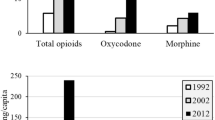Abstract
The pharmacokinetics of valproic acid (VPA) were compared in dogs with those of the prodrugs ethyl valproate (E-VPA), trichloroethyl valproate (T-VPA), and valproyl valproate (V-VPA). Valproic acid, E-VPA, T-VPA, and V-VPA were administered intravenously and orally to six dogs at equimolar doses. The three VPA prodrugs were rapidly converted to VPA. The biotransformation was complete in the case of E-VPA and T-VPA but was only partial in the case of V-VPA. Because of the rapid conversion to the parent drug, after administration of the prodrugs, VPA plasma levels did not yield a sustained-release profile. Further, the anticonvulsant activity of prodrugs was compared in mice to that of VPA and valpromide (VPD). The anticonvulsant activity of E-VPA, T-VPA, and V-VPA was less than that of VPA.
Similar content being viewed by others
REFERENCES
R. H. Levy and D. D. Shen. Valproate—absorption, distribution, and excretion. In R. H. Levy, F. E. Dreifuss, R. H. Mattson, B. S. Meldrum, and J. K. Penry (eds.), Antiepileptic Drugs, Ed. 3, Raven Press, New York, 1989, pp. 583–600.
G. Zaccara, A. Messori, and F. Moroni. Clinical pharmacokinetics of valproic acid—1988. Clin. Pharmacokinet. 15:367–389 (1988).
M. Bialer, M. Friedman, J. Dubrovsky, I. Raz, and O. Abramsky. Pharmacokinetic evaluation of novel sustained release dosage forms of valproic acid. Biopharm. Drug Dispos. 6:401–411 (1985).
F. Pisani, A. Fazio, G. Oteri, and A. Di Perri. Dipropylacetic acid plasma levels: Diurnal fluctuations during chronic treatment with dipropylacetamide. Ther. Drug Monit. 3:297–301 (1981).
F. Pisani and R. Di Perri. Some clinical and pharmacological aspects of n-dipropylacetamide. Ital. J. Neurol. Sci. 4:245–249 (1980).
M. Bialer, A. Rubinstein, I. Raz, and O. Abramsky. Pharmacokinetics of valpromide after oral administration of a solution and a tablet to healthy subjects. Eur. J. Clin. Pharmacol. 27:501–503 (1984).
M. Bialer, A. Rubinstein, J. Dubrovsky, I. Raz, and O. Abramsky. A comparative pharmacokinetic study of valpromide and valproic acid after intravenous administration in humans. Int. J. Pharm. 23:25–33 (1985).
J. W. A. Meijer and R. Kalff. Less usual ways of administering anti-epileptic drugs. In H. Schneider, D. Janz, C. Grader-Thorpe, H. Meinardi, and A. L. Sherwin (eds.), Clinical Pharmacology of Anti-Epileptic Drugs, Springer-Verlag, Berlin, 1975, pp. 222–228.
J. J. Reekers-Ketting, E. van der Kleijn, B. A. Leliveld, A. F. A. M. Schobben, and T. B. Vree. Pharmacokinetics of dipropyl acetate (Depakine) in different dosage forms in man and rhesus monkey. Pharm. Week. 110:1233–1236 (1975).
D. D. Breimer. Clinical pharmacokinetics of hypnotics. Clin. Pharmacokinet. 2:93–107 (1977).
G. Taillandier, J. L. Benoit-Guyod, A. Boucherle, M. Broll, and P. Eymard. Investigation in the dipropylacetic acid series, C8 and C9 branched chain ethylenic acids and amides. Eur. J. Med. Chem. 10:453–462 (1975).
R. J. Porter, J. J. Ceregino, G. D. Gladding, B. J. Hessie, H. J. Kupferberg, B. Scoville, and B. G. White. Antiepileptic drug development program. Cliv. Clin. Q. 51:293–305 (1984).
M. Bialer, M. Friedman, and J. Dubrovsky. A rapid GLC assay for monitoring valproic acid and valpromide in plasma. J. Pharm. Sci. 73:991–993 (1984).
M. Gibaldi and D. Perrier. Pharmacokinetics, Ed. 2, Marcel Dekker, New York, 1982.
L. Z. Benet and R. L. Galeazzi. Non-compartmental determination of steady-state volume of distribution. J. Pharm. Sci. 68:1071–1074 (1979).
K. Yamaoka, T. Nakagawa, and T. Uno. Statistical moments in pharmacokinetics. J. Pharmacokinet. Biopharm. 6:547–558 (1977).
K. Yamaoka. Methods for Pharmacokinetic Analysis for Personal Computers, Ed. 2, Nanko-D Ltd, Tokyo, 1986, pp. 145–175.
M. Bialer and A. Rubinstein. A comparative study on the pharmacokinetics of valpromide after intravenous administration in dogs. J. Pharm. Pharmacol. 35:607–609 (1983).
W. Loscher and H. Esenwein. Pharmacokinetics of sodium valproate in dog and mouse. Arzneim-Forsch./Drug Res. 28:782–787 (1978).
Author information
Authors and Affiliations
Rights and permissions
About this article
Cite this article
Badir, K., Haj-Yehia, A., Vree, T.B. et al. Pharmacokinetics and Anticonvulsant Activity of Three Monoesteric Prodrugs of Valproic Acid. Pharm Res 8, 750–753 (1991). https://doi.org/10.1023/A:1015854118110
Issue Date:
DOI: https://doi.org/10.1023/A:1015854118110




